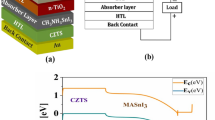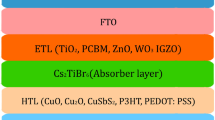Abstract
A planar architecture double perovskite solar cell (DPSC) has been proposed and modeled employing Pb free La2NiMnO6 absorber layer. In present work, fluorine-doped tin oxide (FTO) is employed as transparent electrode, tungsten disulfide (WS2) is used as ETL, cuprous oxide (Cu2O) as HTL and La2NiMnO6 material is utilized as an absorber layer using the simulation program Solar Cell Capacitance Simulator-One Dimensional (SCAPS-1D). Notably, the configuration of the proposed device is FTO/WS2/La2NiMnO6/Cu2O/Au which demonstrates power conversion efficiency (PCE) of 11.41%. Several parameters affecting device performance such as absorber thickness, defect density, series and shunt resistance, interface defect density and various back metal contacts are studied and optimized. The structure exhibits PCE 18.89%, fill factor (FF) 85.52%, open-circuit voltage (Voc) 0.7919 V, and current density (Jsc) 27.89 mA/cm2. The results of the current work might be beneficial for researchers in designing low-cost, highly efficient, and non-toxic inorganic DPSC.










Similar content being viewed by others

References
I. Alam, R. Mollick, M.A. Ashraf, Numerical simulation of Cs2AgBiBr 6-based perovskite solar cell with ZnO nanorod and P3HT as the charge transport layers. Phys. B Condens Matter. 618, 413187 (2021)
S.S. Nair, P. Thakur, F. Wan, A.V. Trukhanov, L.V. Panina, A. Thakur, Performance evaluation and the optimization of an inverted photo-voltaic cell with lead-free double perovskite material and inorganic transport layer materials. Sol. Energy 262, 111823 (2023)
J. Singh, S. Singh, V. Srivastava, S. Sadanand, R. Yadav, P. Lohia, D.K. Dwivedi, Performance enhancement of PbS-TBAI quantum dot solar cell with MoTe 2 as hole transport layer. Phys. Status Solidi 220, 2300275 (2023)
S. Porwal, M. Paul, H. Dixit, S. Mishra, T. Singh, Investigation of defects in Cs2SnI6-based double perovskite solar cells via SCAPS-1D. Adv. Theory Simul. 5, 2200207 (2022)
E. Greul, M.L. Petrus, A. Binek, P. Docampo, T. Bein, Highly stable, phase pure Cs2AgBiBr 6 double perovskite thin films for optoelectronic applications. J. Mater. Chem. A Mater. 5, 19972–19981 (2017)
S. Rai, B.K. Pandey, D.K. Dwivedi, Designing hole conductor free tin–lead halide based all-perovskite heterojunction solar cell by numerical simulation. J. Phys. Chem. Solids 156, 110168 (2021)
S. Rai, B.K. Pandey, D.K. Dwivedi, Modeling of highly efficient and low cost CH3NH3Pb(I1-xClx)3 based perovskite solar cell by numerical simulation. Opt. Mater. 100, 109631 (2020)
S. Rai, B.K. Pandey, A. Garg, D.K. Dwivedi, Hole transporting layer optimization for an efficient lead-free double perovskite solar cell by numerical simulation. Opt. Mater. 121, 111645 (2021)
S. Yadav, P. Lohia, A. Sahu, Enhanced performance of double perovskite solar cell using WO3 as an electron transport material. J. Opt. (India) 52, 776–782 (2022)
S. Chatterjee, A.J. Pal, Influence of metal substitution on hybrid halide perovskites: Towards lead-free perovskite solar cells. J. Mater. Chem. A Mater. 6, 3793–3823 (2018)
J. Kangsabanik, V. Sugathan, A. Yadav, A. Yella, A. Alam, Double perovskites overtaking the single perovskites: A set of new solar harvesting materials with much higher stability and efficiency. Phys. Rev. Mater. 2, 055401 (2018)
M.R. Filip, X. Liu, A. Miglio, G. Hautier, F. Giustino, Phase diagrams and stability of lead-free halide double perovskites Cs2BB′X6: B = Sb and Bi, B′ = Cu, Ag, and Au, and X = Cl Br, and i. J. Phys. Chem. C 122, 158–170 (2018)
M. Sariful Sheikh, D. Ghosh, A. Dutta, S. Bhattacharyya, T.P. Sinha, Lead free double perovskite oxides Ln2NiMnO6 (Ln = La, Eu, Dy, Lu), a new promising material for photovoltaic application. Mater. Sci. Eng. B Solid State Mater. Adv. Technol. 226, 10–17 (2017)
M. Kumar, A. Raj, A. Kumar, A. Anshul, Theoretical evidence of high power conversion efficiency in double perovskite solar cell device. Opt. Mater. 111, 110565 (2021)
M.K. Hossain, A.A. Arnab, D.P. Samajdar, M.H.K. Rubel, M.M. Hossain, M.R. Islam, R.C. Das, H. Bencherif, M.F. Rahman, J. Madan, R. Pandey, S. Bhattarai, M. Amami, D.K. Dwivedi, Design insights into La2NiMnO6-based perovskite solar cells employing different charge transport layers: DFT and SCAPS-1D frameworks. Energy Fuels 37, 13377 (2023)
M. Chen, M.G. Ju, A.D. Carl, Y. Zong, R.L. Grimm, J. Gu, X.C. Zeng, Y. Zhou, N.P. Padture, Cesium titanium(IV) Bromide thin films based stable lead-free perovskite solar cells. Joule. 2, 558–570 (2018)
C. Wu, Q. Zhang, Y. Liu, W. Luo, X. Guo, Z. Huang, H. Ting, W. Sun, X. Zhong, S. Wei, S. Wang, Z. Chen, L. Xiao, The dawn of lead-free perovskite solar cell: highly stable double perovskite Cs2AgBiBr 6 film. Adv. Sci. 5, 1700759 (2018)
M. Burgelman, P. Nollet, S. Degrave, Modelling polycrystalline semiconductor solar cells, n.d. www.elsevier.com/locate/tsf
F. Liu, J. Zhu, J. Wei, Y. Li, M. Lv, S. Yang, B. Zhang, J. Yao, S. Dai, Numerical simulation: toward the design of high-efficiency planar perovskite solar cells. Appl. Phys. Lett. 104, 253508 (2014)
A.K. Chaudhary, S. Verma, R.K. Chauhan, Design of a low-cost, environment friendly perovskite solar cell with synergic effect of graphene oxide-based HTL and CH 3 NH 3 GeI 3 as ETL. Eng. Res. Express. 5, 035039 (2023)
A. Hima, N. Lakhdar, B. Benhaoua, A. Saadoune, I. Kemerchou, F. Rogti, An optimized perovskite solar cell designs for high conversion efficiency. Superlattices Microstruct. 129, 240–246 (2019)
S. Zandi, P. Saxena, N.E. Gorji, Numerical simulation of heat distribution in RGO-contacted perovskite solar cells using COMSOL. Sol. Energy 197, 105–110 (2020)
A. Gupta, S. Yadav, V. Srivastava, D.K. Dwivedi, P. Lohia, A. Umar, M.H. Mahmoud, Simulation of carbon-based perovskite solar cell using PBS-TBAI as a hole transport layer (HTL). Sci. Adv. Mater. 15, 655–661 (2023)
A. Umar, P. Srivastava, S. Rai, P. Lohia, D.K. Dwivedi, H. Algadi, S. Baskoutas, High-performance lead-free perovskite solar cell: a theoretical study. Emerging Materials Research. 12, 1–8 (2023)
K. Decock, S. Khelifi, M. Burgelman, Modelling multivalent defects in thin film solar cells, in: Thin Solid Films, 2011, pp. 7481–7484
P. Tiwari, M.F. Alotaibi, Y. Al-Hadeethi, V. Srivastava, B. Arkook, P. Lohia, D.K. Dwivedi, A. Umar, H. Algadi, S. Baskoutas, Design and simulation of efficient SnS-based solar cell using spiro-OMeTAD as hole transport layer. Nanomaterials 12, 2506 (2022)
A. Umar, V. Yadav, V. Srivastava, P. Lohia, D.K. Dwivedi, A.A. Ibrahim, S. Akbar, H. Qasem, S. Baskoutas, Optimizing quantum dot solar cells: exploring defect density effects with PTAA HTL layer simulation using SCAPS-1D. Emerg. Mater. Res. 12, 1–9 (2023)
S. Abdelaziz, A. Zekry, A. Shaker, M. Abouelatta, Investigating the performance of formamidinium tin-based perovskite solar cell by SCAPS device simulation. Opt. Mater. 101, 109738 (2020)
A.A. Kanoun, M.B. Kanoun, A.E. Merad, S. Goumri-Said, Toward development of high-performance perovskite solar cells based on CH3NH3GeI3 using computational approach. Sol. Energy 182, 237–244 (2019)
H.B. Michaelson, The work function of the elements and its periodicity. J. Appl. Phys. 48, 4729–4733 (1977)
A. Umar, V. Yadav, V. Srivastava, P. Lohia, D.K. Dwivedi, A.A. Ibrahim, M.A.M. Alhamami, H. Qasem, S. Akbar, Simulation of efficient lead sulfide colloidal quantum dot solar cell using spiro-OMeTAD as hole transport layer. Sci. Adv. Mater. 14, 1741–1749 (2023)
V. Srivastava, R.K. Chauhan, P. Lohia, Theoretical study of lead-free perovskite solar cell using ZnSe as ETL and PTAA as HTL. Emerg. Mater. Res. 11, 37–46 (2022)
A. Gupta, V. Srivastava, S. Yadav, P. Lohia, D.K. Dwivedi, A. Umar, M.H. Mahmoud, Performance enhancement of perovskite solar cell using SrTiO 3 as electron transport layer. J. Nanoelectron. Optoelectron. 18, 452–458 (2023)
V. Srivastava, R.K. Chauhan, P. Lohia, Highly efficient cesium-based halide perovskite solar cell using SCAPS-1D software: theoretical study. J. Opt. (India) 52, 1218–2125 (2023)
U. Mandadapu, S.V. Vedanayakam, K. Thyagarajan, M.R. Reddy, B.J. Babu, Design and simulation of high efficiency tin halide perovskite solar. Cell 7, 1604–1612 (2017)
R. Singh, A. Giri, M. Pal, K. Thiyagarajan, J. Kwak, J.J. Lee, U. Jeong, K. Cho, Perovskite solar cells with an MoS2 electron transport layer. J. Mater. Chem. A Mater. 7, 7151–7158 (2019)
T. Minemoto, M. Murata, Impact of work function of back contact of perovskite solar cells without hole transport material analyzed by device simulation. Curr. Appl. Phys. 14, 1428–1433 (2014)
P. Liu, V.P. Singh, C.A. Jarro, S. Rajaputra, Cadmium sulfide nanowires for the window semiconductor layer in thin film CdS-CdTe solar cells. Nanotechnology 22, 145304 (2011)
S. Bhattarai, I. Hossain, M. Maiti, R. Pandey, J. Madan, Performance analysis and optimization of all-inorganic CsPbI3-based perovskite solar cell. Indian J. Phys. (2023)
V. Srivastava, R.K. Chauhan, P. Lohia, Investigating the performance of lead-free perovskite solar cells using various hole transport material by numerical simulation. Trans. Electr. Electron. Mater. 24, 20–30 (2023)
A. Kannaujiya, A.K. Patel, S. Kannaujiya, A.P. Shah, Efficient CZTSSe thin film solar cell employing MoTe2/MoS2 as hole transport layer. Micro Nanostruct. 169, 207356 (2022)
P. Srivastava, S. Rai, P. Lohia, D.K. Dwivedi, H. Qasem, A. Umar, S. Akbar, H. Algadi, S. Baskoutas, Theoretical study of perovskite solar cell for enhancement of device performance using SCAPS-1D. Phys. Scr. 97, 125004 (2022)
V. Srivastava, R.K. Chauhan, P. Lohia, Numerical analysis of Cs 2 AgBiBr 6 double-perovskite solar cell with optimized performance. Nanomater. Energy 12, 1–8 (2023)
A. Umar, P. Srivastava, S. Rai, P. Lohia, D.K. Dwivedi, H. Algadi, S. Baskoutas, High-performance lead-free perovskite solar cell: a theoretical study. Emerg. Mater. Res. 12, 92–99 (2023)
S. Singh, S. Kumar, M. Deo, R.K. Chauhan, Unveiling the potential of organometal halide perovskite materials in enhancing photodetector performance. Opt. Quantum Electron. 55, 846 (2023)
P. Chauhan, S. Agarwal, V. Srivastava, M.K. Hossain, R. Pandey, J. Madan, P. Lohia, D.K. Dwivedi, M. Amami, Kesterite CZTS based thin film solar cell: generation, recombination, and performance analysis. J. Phys. Chem. Solids 183, 111631 (2023)
P. Dubey, B.K. Pandey, D.K. Dwivedi, Contribution towards the selection of electron and hole transport layers for the development of highly efficient PbS colloidal quantum dot solar cell. Optik 266, 169600 (2022)
K.S. Bhardwaj, S. Rai, P. Lohia, D.K. Dwivedi, Investigating the performance of mixed cation mixed halide-based perovskite solar cells using various hole-transport materials by numerical simulation. Opt. Quantum Electron. 53, 1–16 (2021)
Acknowledgements
This work was funded by the Researchers Supporting Project Number (RSPD2023R664) King Saud University, Riyadh, Saudi Arabia. The author expresses his indebtedness to Dr. Marc Burgelman, for SCAPS-ID simulation tool, University of Ghent, Belgium.
Funding
This work was funded by the Researchers Supporting Project Number (RSPD2023R664) King Saud University, Riyadh, Saudi Arabia.
Author information
Authors and Affiliations
Contributions
All authors make equal contributions.
Corresponding author
Ethics declarations
Conflict of interest
Authors have no conflict of interest.
Additional information
Publisher's Note
Springer Nature remains neutral with regard to jurisdictional claims in published maps and institutional affiliations.
Rights and permissions
Springer Nature or its licensor (e.g. a society or other partner) holds exclusive rights to this article under a publishing agreement with the author(s) or other rightsholder(s); author self-archiving of the accepted manuscript version of this article is solely governed by the terms of such publishing agreement and applicable law.
About this article
Cite this article
Singh, A., Srivastava, V., Singh, S. et al. Optimization of highly efficient inorganic lead-free double perovskite solar cells via SCAPS-1D. J Opt (2023). https://doi.org/10.1007/s12596-023-01440-2
Received:
Accepted:
Published:
DOI: https://doi.org/10.1007/s12596-023-01440-2



